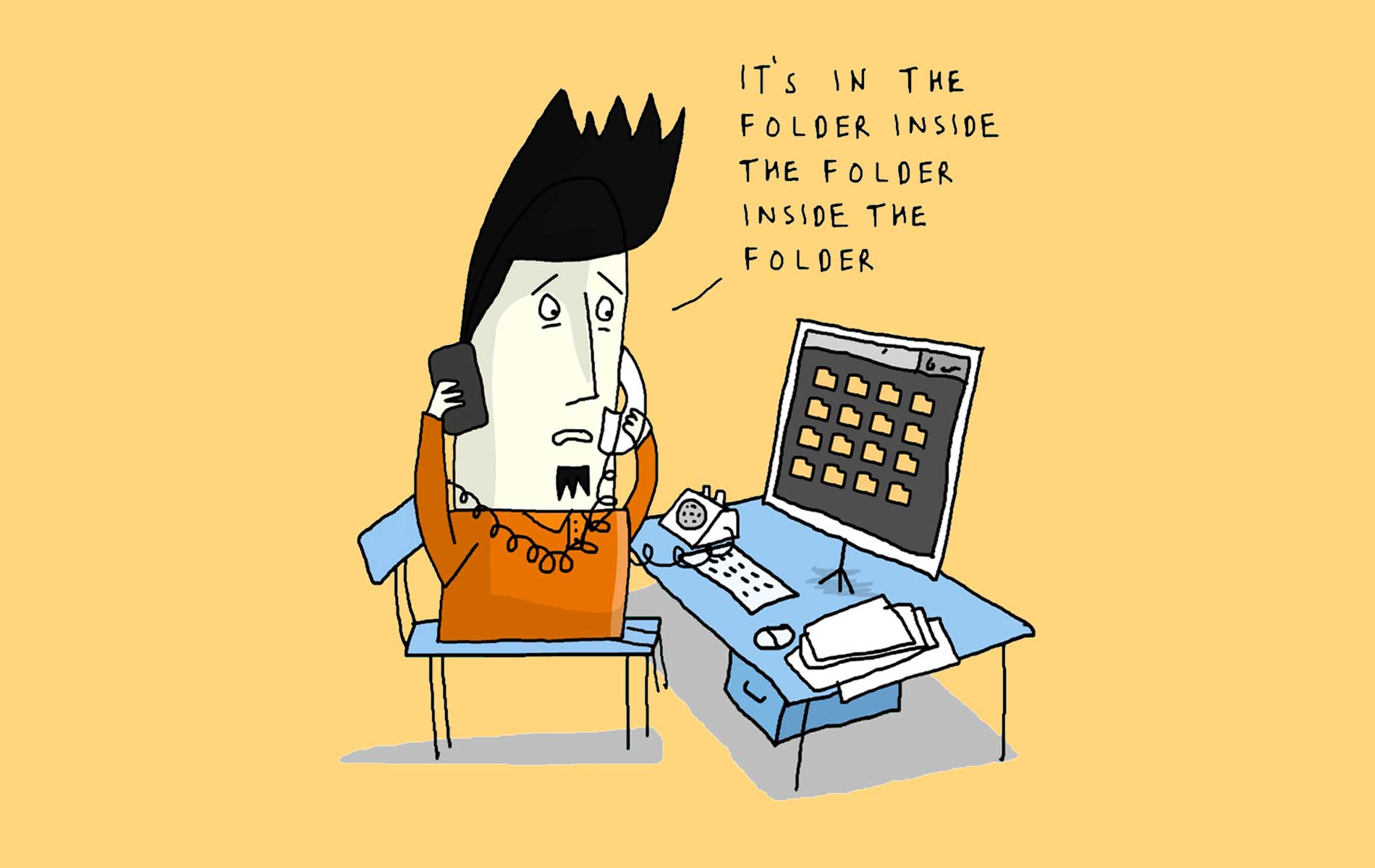On average, we spend 9.3 hours per week searching for and gathering information.
We want to let you in on a secret – the number of files you create and the cloud projects you work on are only going to increase! If you are struggling to keep track of your files and cloud projects now, just think about the future!
When asking teams about how they organize their files and cloud projects, the common answer is a combination of platforms to do one job. From traditional file management platforms like Dropbox, Box, and Google Drive, to file sharing platforms like WeTransfer – and even hard drive and local server – one platform doesn’t solve their problems. Some have made the move to a Digital Asset Management (DAM) platform like Bynder, Brandfolder, Canto, and Cloudinary – but with that came additional cost and a steep learning curve.
The pain of managing files with teams is real.
If this story sounds familiar, you’re definitely not alone! The sheer number of digital files, cloud tools, and links you use in one day can be overwhelming. Every time you can’t find a file – or someone asks you for one that they should be able to find themselves – is time you aren’t being productive!
Here are some of the challenges we repeatedly hear:
- I can’t access the files I need because I don’t have a user license.
- I can’t access the files I need because I ran out of storage.
- I can’t find the files I need because they are buried in a confusing folder structure.
- My cloud project and associated files feel disjointed.
- It’s hard to share files. I keep getting blocked because of the file type and size.
- I can’t get my whole team in one place because I don’t have the budget for additional user licenses.
- I can’t tell which version of a file is the most recent because there are too many copied versions.
The limitations of traditional file management and cloud file storage platforms:
What Dropbox, Box, and Google Drive have done for the digital landscape is nothing short of remarkable – but the way people work and think in a digital sense has changed. While there will always be a space for these platforms, some organizations are looking for more.
![]()
Folder structures
With traditional file management platforms, you are forced to duplicate files if you want them to live in two (or more) folders. This not only increases storage costs but can create confusion about which file is the right one. You’ll very quickly have a lot of image02_copy.jpg files on your hands.
Searching for and finding files
Without very detailed file names, searching for your files can be difficult, leaving teams to rely on a complex folder structure for file organization. Even then, searching for anything detailed around a particular file such as the date it was taken or made, the subject, the contents, or even the original uploader, can be impossible.
File restrictions and storage space
Trying to receive assets from freelancers or external partners can create confusion and extra steps when user licenses and storage limits are in place. Have you ever shared a folder with someone, just to find out they didn’t have the storage space to collaborate with you? This can lead to files being shared via temporary share links that need to be downloaded and uploaded to your file management system. That’s a lot of steps!
Team collaboration
For growing teams, paying for user licenses can add up. In some cases, teams can be made of internal and external users – but there isn’t always the budget to add more licenses for temporary collaboration. This can lead to multiple platforms being used to do one job and files being stored in various places.
The limitations of incumbent enterprise digital asset management platforms:
Digital asset management is a well-honed practice that some dedicate their entire careers to. But DAM platforms can be complex, expensive, and often prohibitive for teams who don’t have a resident DAM expert.
Lack of organizational structure
To most, a digital asset management platform structure can look confusing at a glance. The lack of organizational structure and the multitude of configuration settings can be overwhelming to those who are used to a simple file and folder structure. Navigating the changes, without proper training, can render a DAM and its features, useless.
Custom configurations, teams, and roles.
Out of the box, some DAM platforms can have pre-set user roles for your users. Creating customized roles for your needs could be billed out at project costs or not possible at all. The same goes for custom features. Instead of configurable settings, customizations for your instance could be viewed as add-ons or additional development.
Dedicated resources
Digital asset management platforms often require a specialist resource to be used effectively. They can be costly to run, implement and scale without this resource to keep track of files, metadata, teams, and overall organization.
Cost-prohibitive user licenses
DAM platforms tend to price based on cost per-user licenses in pre-set storage tiers. This can lead to siloed businesses with licenses being rationalized according to budget or need.
There is never a better time to transform the way you get organized.
Transformation should be liberating, especially when the benefits can be seen so quickly. By implementing an organized and consistent way to manage your files, you can make it quicker and easier for your team to find and use what they’re looking for.

83% of employees have to recreate pre-existing documents because they can’t find the files they created before.
A better way of managing files and cloud projects can help teams of all types find what they’re looking for.
Work with ONE file in multiple places
Always know which file is the right one – because there’s only one! By utilizing a platform where one file can live in multiple places without being duplicated, you’ll never have to choose between image_copy.jpg or image_copy copy.jpg, ever again!
Find your files quickly and easily with tags and custom metadata
Reduce reworking: 83% of employees have to recreate pre-existing documents because they can’t find the files they created before. Reduce the chances of reworking with a search driven by custom and AI tags and metadata associated with files such as file extension, upload date, file owner, and more. Find what you need, when you need it so that you don’t have to re-make it!
Unlimited users
Limit repeat requests: With no user license restrictions, every member of your team can be added as a user and organized into teams. Invited these users to collaborate on the assets they need to reduce requests for assets. With no blockers to accessing files and cloud project links, there is no need to request files they can get to themselves.
Collaboration for teams
Quicker review and approvals: When new files are added to Collections, collaborators are notified to keep workflows clean, simple, and timely. File statuses can be changed according to approval or depreciation of files and are completely customizable.
Simplify communication: In-platform commenting directly on files keeps communication centered around the assets versus lost in an email chain or slack.
File versioning
Better version control: Keep new versions of files together to avoid duplicate content. The latest version of the file will always appear in the workspace search, but previous versions can be viewed and restored as required.
Transformation shouldn’t be scary – it should make you say, “why did we wait so long!?”
You’ve transformed your communication with Slack and Microsoft Teams, and you’ve sorted your workflow with Asana and Monday, now it’s time to transform the way you organize and collaborate on your files and cloud projects with Stockpress.
Stockpress isn’t only for organizing and sharing files, it’s a tool to improve collaboration. Teams use Stockpress as a single hub for organizing, sharing, and collaborating on files and cloud projects – together.
If you’re looking for more than just folders, DAM is the next natural step. But why not use a platform that combines the best of both?
Could you and your team benefit from:
- Collaborating with your entire team without having to use fragmented platforms.
- Keeping working documents with final documents all in one place.
- Adding tags and custom metadata during upload.
- Mapping and syncing of metadata.
- Organizing your files in a structure familiar to folders, but without the need to duplicate them.
- Unlimited internal and external users licenses
- Unlimited custom user roles and permissions.
- Unlimited teams and permissions.
- Organizing cloud projects alongside your files.
- Custom reports based on usage and user behavior to inform optimized organization and content creation planning.
- Sharing any file type or size with internal or external users.
- Whether you call it file management, cloud file storage, or digital asset management – why not transform the way you organize, find, use and share files and cloud projects with Stockpress? You can get started for free with unlimited users and 3 GB of storage today.
Plan for growth with our transparent pricing packages or try our cost calculator:

